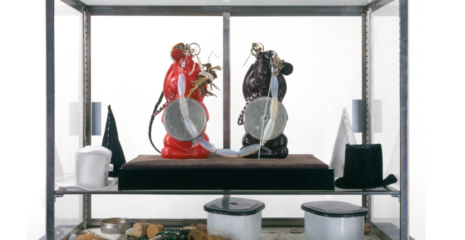
January 6, 4:00 PM–6:00 PM
Join us on Saturday, January 6th for a free, public artist talk with exhibiting artist Nayland Blake. His work is on view in Franklin Street Works’ current exhibition, “I hear it everywhere I go.” Time TBD.
Nayland Blake, who earned his MFA from the California Institute of the Arts in 1984, has exhibited his work internationally in solo and group exhibitions. Interracial desire, same-sex love, and racial and sexual bigotry are recurrent themes in Blake’s sculptures, drawings, performances, and videos, which reflect his preoccupation with his own racial and sexual identities. Blake participated in the 1991 Whitney Biennial and the 1993 Venice Biennale. The Tang Teaching Museum and Art Gallery at Skidmore College, Saratoga Springs, New York, presented a survey of his performance-based work in 2003, and his work was the subject of a 2008 survey exhibition at Location One, New York. In 2012 Yerba Buena Arts Center in San Francisco presented a one-man exhibition entitled “Free!Love!Tool!Box!” and Blake was awarded a Guggenheim fellowship. Blake chairs the International Photography Center-Bard MFA program and lives and works in Brooklyn.
Blake’s work is on view in “I hear it everywhere I go,” a group exhibition curated by Terri C Smith. The show’s curatorial premise was inspired by artist Cady Noland’s (b. 1956) writings on and statements about American life. During her career in the 1980s and 90s, Noland explored the American tendency to vent violent impulses through socially acceptable release valves such as figuratively “trashing” celebrities on the one hand and conning or preying on populations outside of dominant power structures – often in the name of entrepreneurship – on the other. Exhibiting artists are: Alex Bag, Michael Blake, Nayland Blake, Jen DeNike, Jonah Freeman & Justin Lowe, Rashid Johnson, Adam McEwen, Rodney McMillian, Tameka Norris, Cheryl Pope, Mikel Rouse, and Melissa Vandenberg.
The artists in “I hear it everywhere I go” exponentially expand on and add to the show’s themes with strategies that include: performed fictions that resituate celebrity and commodity culture; collaborative text pieces that give institutionally marginalized voices visibility; pop culture appropriations exploring the isolation of fame; the mining of distinctly American signifiers like varsity sports and daytime TV talk shows; and juxtapositions of post-consumer objects and mass-produced materials that read on multiple levels and often indicate how people’s race, class, gender, and sexuality can position them in a simultaneous state of hypervisibility and invisibility in American culture.
“‘I hear it everywhere I go’ aspires, emotes, dreams, mourns, carps, and converses about identities, highlighting ways expectations can be colored by unconscious efforts to acquire the perceived successes of the American Dream,” Smith says.
